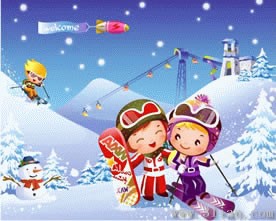| Equipment of Skiing | ||
http://english.dbw.cn
2013-11-21 15:22:31
|
||
|
Alpine skis vary in construction, but they all have a hard plastic top surface, a polyethylene running surface, and steel edges. They are composed of a core material, either foam or wood, with layers of fiberglass and sometimes metal. Ski length is determined by a number of variables, including a skier’s height, weight, and ability. The taller and heavier the skier, the longer the ski. Beginners generally use shorter skis for easier maneuvering. Ski lengths for adults range from about 150 to 210 cm (about 5 to 7 ft). One of the newer innovations in Alpine ski design is the so-called shaped ski, also known as the cut, super sidecut, parabolic, or hourglass ski. The name comes from the ski’s shape: a wide tip, a narrow waist, and a wide tail. Whereas traditional skis are wide at the tip and tail and slightly narrower through their middle, shaped skis have greater variation in width. These skis are specifically designed to make it easier to carve a turn. Although they were originally designed for beginning and intermediate skiers, many advanced skiers and racers have begun using shaped skis as well. Shaped skis are typically 8 to 15 cm (3 to 6 in) shorter than traditional skis. There are several variations on Alpine ski equipment. One is the monoski, which is a single, wide board. Another popular piece of equipment is the skiboard, which is also called the mini-ski. Skiboards are only about 60 cm (24 in) long. Because of their short length, they allow skiers great maneuverability on the slopes. A more recent innovation is the ski bike, which combines cycling and skiing. The ski bike has handlebars and a seat, just like a bicycle, but it has boards instead of wheels. Riders wear short skis on their feet to help steer. Snow scoots are similar to ski bikes, but they have no seat, and riders secure their feet in footstraps. Riders steer by leaning back and forth to put pressure on the edges of the board. Cross-country skis are narrower and lighter weight than Alpine skis, and construction is similar to Alpine skis but omits the metal edges. Skating skis range in length from about 170 to 190 cm (about 5 ft 7 in to 6 ft 3 in) for adults. Compact skis, which make learning easy, are about 150 cm long. Touring, or diagonal-stride, skis range in length from about 160 to 210 cm (about 5 ft 3 in to 7 ft). Wax applied to the middle part of the ski base helps Nordic skiers glide. Some Nordic skis are dubbed waxless. They have scales on the base that perform the function of wax. Skating skis do not require wax at all. Alpine skiers also use wax, especially in racing events, to increase speed. Telemark skis resemble cross-country skis but have metal edges. They are the equipment of choice for backcountry skiers, who may do some climbing. Strips of material fastened to the bottom of each ski allow the ski to slide when pushed forward but prevent it from slipping backward. Special wax also makes climbing easier. Alpine boots are made of hard plastic with an inside liner that provides warmth and a snug fit. The boots attach to the skis by means of toe and heel bindings, which are screwed into the skis. Alpine bindings are designed to release the boot from the ski in the event of a fall, thus reducing the chance of injury. Poles are usually made of aluminum and are used for balance and for timing turns. Newer models are made of composites and are thinner and lighter than traditional poles. A small plastic basket at the end of each pole prevents the pole from sinking into the snow. Nordic boots are usually made of leather, and they resemble a shoe or hiking boot with an extended toepiece to fit into the bindings. Telemark boots resemble sturdy hiking boots. Nordic and telemark bindings attach only the toe of the boot to the ski, leaving the heel free to move up and down. Strips on the binding that match grooves in the boot help keep the boot from slipping off to one side of the ski. Poles are more important in cross-country skiing than in Alpine skiing, since they are used for propulsion as well as balance. Most recreational poles are made of aluminum; higher-end racing poles are made of lightweight composites. Cross-country poles are longer than Alpine poles. For diagonal striding, skiers usually use poles that come up to the armpit; those for the skating stride reach somewhere between the chin and nose. Ski clothing is designed to keep the skier warm and dry. The best way to dress for Alpine skiing is in layers: The underlayer carries moisture away from the skin and adds warmth, the second layer insulates, and the outer layer resists water and wind. Cross-country skiers follow the same principles in dressing, but their clothing is not as heavy because they generate more body heat by moving continuously. Many Alpine skiers wear helmets specially designed for the sport. Goggles are important in providing good visibility when weather is bad. When the weather is good, goggles can also help protect the eyes from the glare of the sun on the snow. (Northeast web) |
||
| Author: Source: dbw.cn Editor: Yang Fan |
||
 中文简体
中文简体











